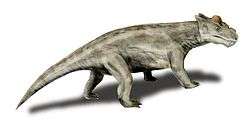Biarmosuchia
| Biarmosuchia | |
|---|---|
.jpg) | |
| Mounted skeleton of Biarmosuchus tener | |
| Scientific classification | |
| Kingdom: | Animalia |
| Phylum: | Chordata |
| Order: | Therapsida |
| Suborder: | †Biarmosuchia Sigogneau-Russell, 1989 |
| Subgroups | |
Biarmosuchia is a group of Permian therapsids. Biarmosuchians are the most basal group of therapsids. They were moderately sized, lightly built carnivores, intermediate in form between the sphenacodont pelycosaurs and more advanced therapsids.
Characteristics

The biarmosuchian skull is very similar to the sphenacodont skull, differing only in the larger temporal fenestra (although these are still small relative to later therapsids), slightly backward-sloping occiput (the reverse of the pelycosaur condition), reduced number of teeth, and single large canine teeth in both upper and lower jaws, and other features (Carroll 1988 pp. 370, Benton 2000 p. 114). In later specialised Biarmosuchia, these resemble the enlarged canines of the Gorgonopsia. The presence of larger jaw-closing muscles (and hence a stronger bite) is indicated by the flaring of the rear of the skull where these muscles were attached.
The vertebrae are also sphenacodontid-like (but lack the long neural spines that distinguish Dimetrodon and its kin), but the shoulder and pelvic girdles and the limbs indicate a much more advanced posture. The feet are more symmetrical, indicating that they faced forward throughout the stride, and the phalanges (toes) are reduced in length so that they are more like that of later synapsids (therapsids and mammals) (Carroll 1988 pp. 370–1).
Distribution
Currently the most representative group of the Biarmosuchia, the Burnetiamorpha comprise ten genera: Bullacephalus, Burnetia, Lemurosaurus, Lobalopex, Lophorhinus, Paraburnetia, and Pachydectes from South Africa, Niuksenitia and Proburnetia from Russia, and Lende (MAL 290) from Malawi.[1] In addition, Sidor et al. (2010)[2] recently described a partial skull roof including the dorsal margin of orbits and parietal foramen of an unnamed burnetiid from the upper Permian of Tanzania, and Sidor et al. (2014) [3] noted the presence of a burnetiid in the middle Permian of Zambia. Other Biarmosuchia include Biarmosuchus from Russia, Hipposaurus, Herpetoskylax, Ictidorhinus and Lycaenodon from South Africa, and Wantulignathus from Zambia.[4]
Classification
Taxonomic history
Hopson and Barghusen (1986 p. 88) tentatively united Biarmosuchidae and Ictidorhinidae (including Hipposauridae and Rubidginidae) as "Biarmosuchia", but were undecided as to whether they constituted a natural group or an assemblage that had in common only shared primitive characteristics. They thought that Phthinosuchus was too poorly known to tell if it also belonged, but considered Eotitanosuchus a more advanced form.
Sigogneau-Russell (1989) erected the infraorder Biarmosuchia to include the families Biarmosuchidae, Hipposauridae and Ictidorhinidae, distinct from Eotitanosuchia and Phthinosuchia.
Ivakhnenko (1999) argued that Biarmosuchus tener, Eotitanosuchus olsoni, and Ivantosaurus ensifer, all known from the Ezhovo locality, Ocher Faunal Assemblage, are actually the same species. Even if these taxa are shown to be distinct, Ivakhnenko's paper indicates that Eotitanosuchus and Biarmosuchus are very similar animals. Ivakhnenko also relocates the family Eotitanosuchidae to the order Titanosuchia, superorder Dinocephalia.
Benton 2000 and 2004 gives the Biarmosuchia the rank of suborder.
Phylogeny
Below is a cladogram modified from Sidor and Smith (2007):[5]
| Biarmosuchia |
| ||||||||||||||||||||||||||||||||||||||||||||||||||||||||||||||||||
See also
References
- ↑
- Kruger, A., B. S. Rubidge, F. Abdala, E. Gomani Chindebvu, and L. L. Jacobs. 2015. Lende chiweta, a new therapsid from Malawi, and its influence on burnetiamorph phylogeny and biogeography. Journal of Vertebrate Paleontology. DOI: 10.1080/02724634.2015.1008698.
- ↑ Sidor, C. A., K. D. Angielczyk, D. M. Weide, R. M. H. Smith, S. J. Nesbitt, and L. A. Tsuji. 2010. Tetrapod fauna of the lowermost Usili Kruger et al.—A new burnetiamorph from Malawi (e1008698-9) Downloaded by [The Library, University of Witwatersrand] at 23:15 01 November 2015 Formation (Songea Group, Ruhuhu Basin) of southern Tanzania, with a new burnetiid record. Journal of Vertebrate Paleontology 30:696–703.
- ↑ Sidor, C. A., K. D. Angielczyk, R. M. H. Smith, A. K. Goulding, S. J. Nesbitt, B. R. Peecook, J. S. Steyer, and S. Tolan. 2014. Tapinocephalids (Therapsida:Dinocephalia) from the Permian Madumabisa Mudstone Formation (Lower Karoo, Mid-Zambezi Basin) of southern Zambia. Journal of Vertebrate Paleontology 34:980–986.
- ↑ Whitney, M.R. & Sidor, C.A. (July 2016). "A new therapsid from the Permian Madumabisa Mudstone Formation (mid-Zambesi Basin) of southern Zambia". Journal of Vertebrate Paleontology. 36 (4): e1150767. doi:10.1080/02724634.2016.1150767.
- ↑ Sidor, C.A.; Smith, R.M.H. (2007). "A second burnetiamorph therapsid from the Permian Teekloof Formation of South Africa and its associated fauna". Journal of Vertebrate Paleontology. 27 (2): 420–430. doi:10.1671/0272-4634(2007)27[420:ASBTFT]2.0.CO;2.
Further reading
- Benton, M. J. (2000), Vertebrate Paleontology, 2nd Ed. Blackwell Science Ltd. (2004) 3rd edition
- Carroll, R. L. (1988), Vertebrate Paleontology and Evolution, WH Freeman & Co.
- Hopson, J.A. and Barghusen, H.R. (1986), An analysis of therapsid relationships in N Hotton, III, PD MacLean, JJ Roth and EC Roth, The Ecology and Biology of Mammal-like Reptiles, Smithsonian Institution Press, pp. 83–106
- Ivakhnenko, M.F. 1999, Biarmosuches from the Ocher Faunal Assemblage of Eastern Europe, Paleontological Journal vol 33 no.3 pp. 289–296. abstract
- Sigogneau-Russell, D., 1989, "Theriodontia I - Phthinosuchia, Biarmosuchia, Eotitanosuchia, Gorgonopsia" Part 17 B I, Encyclopedia of Paleoherpetology, Gutsav Fischer Verlag, Stuttgart and New York,
External links
- Therapsida: Biarmosuchia at Palaeos